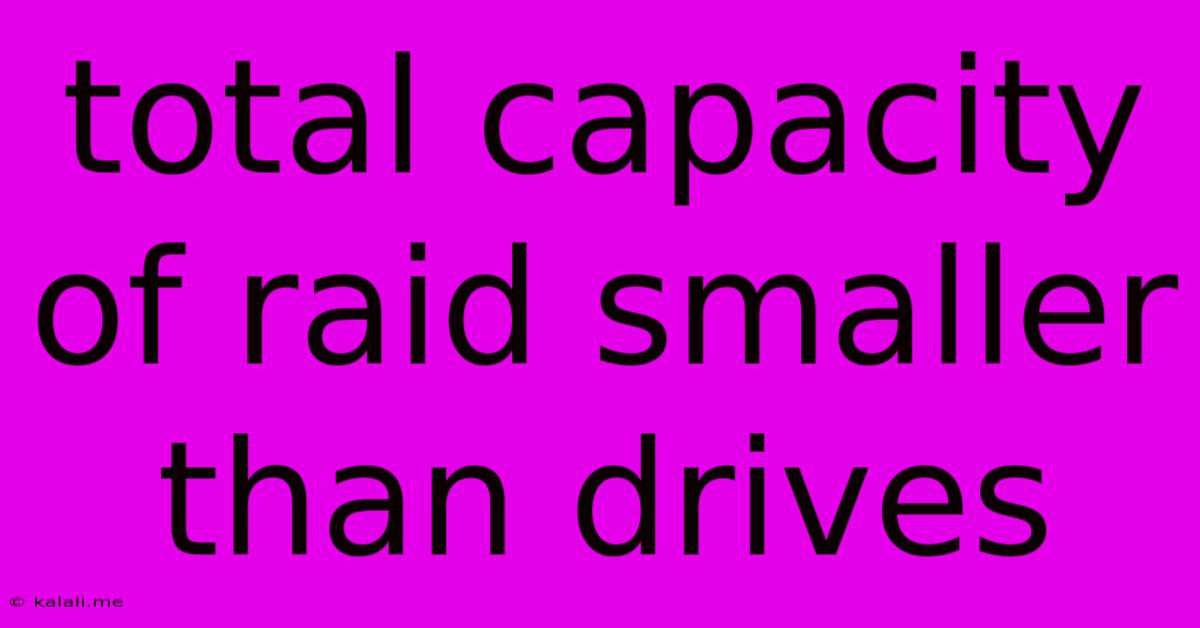Total Capacity Of Raid Smaller Than Drives
Kalali
Jun 03, 2025 · 3 min read

Table of Contents
Why Your RAID Array's Total Capacity Is Smaller Than the Sum of Your Drives
This article explains why the total usable capacity of a Redundant Array of Independent Disks (RAID) system is often less than the sum of the individual hard drive or SSD capacities. Understanding this is crucial for planning and managing your storage effectively. We'll explore the common RAID levels and how they impact storage capacity. By the end, you'll be able to accurately estimate the usable space in your RAID array.
Understanding RAID Levels and Capacity Implications
RAID isn't just about data redundancy; it also affects how your storage space is utilized. Different RAID levels have varying impacts on capacity, primarily due to how they handle parity data (data used for redundancy and data recovery).
-
RAID 0 (Striping): This level offers the highest performance but no redundancy. Data is striped across all drives, so a failure of any drive results in complete data loss. The total usable capacity is the sum of all drive capacities. However, it's crucial to note that RAID 0 is not fault-tolerant.
-
RAID 1 (Mirroring): Data is mirrored (copied) across two or more drives. This provides excellent redundancy as data is duplicated. The usable capacity is equal to the capacity of the smallest drive in the array. For example, if you use two 2TB drives in a RAID 1 configuration, you'll only get 2TB of usable space.
-
RAID 5 (Striping with Parity): This is a popular choice offering both performance and redundancy. Data is striped across drives, and parity information is distributed across the drives. It requires at least three drives. The usable capacity is (number of drives - 1) * smallest drive capacity. For example, with three 2TB drives, you'd get approximately 4TB of usable space (2TB x 2).
-
RAID 6 (Striping with Double Parity): Similar to RAID 5, but uses double parity, allowing it to tolerate two drive failures. This provides even greater redundancy but at the cost of capacity. The usable capacity is (number of drives - 2) * smallest drive capacity. With four 2TB drives, you'd have around 4TB of usable space.
-
RAID 10 (Mirrored Stripes): This combines the benefits of RAID 1 and RAID 0. Drives are mirrored, and the mirror sets are then striped together. It requires an even number of drives and offers both high performance and redundancy. The usable capacity is half the total capacity of all drives; for example, four 2TB drives yield 4TB usable space.
Factors Affecting Usable Capacity
Beyond the RAID level itself, other factors can reduce your available storage:
- Formatting and File System Overhead: The file system (like NTFS or ext4) requires some space for its own metadata and management. This overhead is relatively small but contributes to the difference.
- System Reserved Partitions: Operating systems often create reserved partitions for booting and system files. This uses a small amount of space.
- RAID Controller Overhead: Some RAID controllers might reserve a small amount of space for their internal operations. This is usually negligible.
Calculating Usable RAID Capacity
It's best to use a RAID capacity calculator provided by your RAID controller manufacturer or a trusted online tool. This will give the most accurate estimate based on your specific hardware and chosen RAID level. However, using the formulas mentioned above provides a good approximation. Remember to always use the smallest drive size in your array for the calculations.
Conclusion:
The total usable capacity of a RAID array is almost always less than the raw sum of the drive capacities. Understanding the impact of the RAID level and other factors is vital for accurate storage planning. Always factor in this capacity reduction when choosing a RAID configuration to avoid unexpected storage limitations. Remember to consult your RAID controller's documentation or manufacturer's website for the most accurate capacity information specific to your hardware.
Latest Posts
Latest Posts
-
Steam Games Wont From Macbook Launchpad
Jun 05, 2025
-
How To Find The Null Space
Jun 05, 2025
-
What Did Buddha Say About Jesus
Jun 05, 2025
-
Bash Break Out Of For Loop
Jun 05, 2025
-
Do People Use Mayonnaise For Potato Salad Spain Google Ai
Jun 05, 2025
Related Post
Thank you for visiting our website which covers about Total Capacity Of Raid Smaller Than Drives . We hope the information provided has been useful to you. Feel free to contact us if you have any questions or need further assistance. See you next time and don't miss to bookmark.